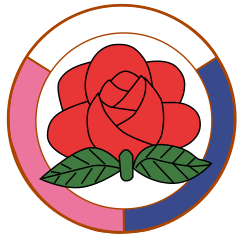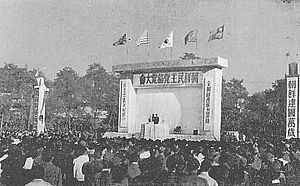Korean Social Democratic Party facts for kids
Quick facts for kids
Korean Social Democratic Party
조선사회민주당
|
|
|---|---|
 |
|
| Chairman | Kim Ho-chol |
| Vice-Chairman | Ri Kum-chol |
| Founder | Cho Man-sik |
| Founded | 3 November 1945 |
| Headquarters | Pyongyang |
| Newspaper |
|
| Membership | 30,000+ (2007 est.) |
| Ideology | Social democracy (de jure) |
| National affiliation | Democratic Front for the Reunification of Korea (1949–2024) |
| Slogan | Independence, sovereignty, democracy, peace and the defence of human rights |
| Party flag | |
 |
|
| Korean Social Democratic Party | |
| Hangul |
조선사회민주당
|
|---|---|
| Hanja |
朝鮮社會民主黨
|
| RR | Joseon sahoe minjudang |
| MR | Chosŏn sahoe minjudang |
The Korean Social Democratic Party (KSDP) is a political group in North Korea. It works closely with the main ruling party, the Workers' Party of Korea (WPK). The KSDP started on November 3, 1945. It was first called the Korean Democratic Party.
It was formed by a mix of people, including business owners, traders, craftspeople, farmers, and Christians. The party's founders wanted to end the influence of Japanese rule. They also aimed to build a new democratic society in Korea. Over time, the party came under the strong influence of the North Korean government. Today, the WPK effectively controls it.
Contents
History of the Korean Social Democratic Party

The party began in Pyongyang on November 3, 1945. Cho Man-sik founded it as the Korean Democratic Party. It quickly gained many supporters, including Christian business people and thinkers. Many workers also joined.
After a few weeks, it had about half a million members. However, Soviet reports said it had 141,000 members by May 1946. Cho Man-sik was forced to make Choe Yong-gon his deputy. Choe Yong-gon was secretly a supporter of the communists. Communists also tried to join and influence the party.
Early Challenges and Leadership Changes
In December 1945, the Moscow Conference took place. Leaders from the Soviet Union, the UK, and the US agreed to temporarily govern Korea together. This plan was called a "trusteeship." Cho Man-sik did not agree with this plan. Many people protested against it.
On January 2, 1946, the party's main committee voted against the trusteeship. Cho Man-sik then resigned from his leadership role on January 5. Many party members followed his example. Soon after, Soviet authorities arrested Cho Man-sik.
His arrest caused many party leaders to move to Seoul in South Korea. They set up a new main office there. In North Korea, the party held its first big meeting on February 24, 1946. Choe Yong-gon was officially chosen as the new leader. Cho Man-sik was called a "traitor." After this, many of Cho's supporters were removed from the party.
Joining the Democratic Front
The Korean Democratic Party later joined the Democratic Front for the Reunification of Korea. This happened on July 22, 1949. This meant the party became less independent. It was now under the control of the Communist Party of Korea. This communist party later became the Workers' Party of Korea.
The KDP held its second big meeting from April 13 to 15, 1947. They continued to criticize Cho Man-sik. They also praised the Soviet Army. The party's structure became very similar to the Workers' Party of North Korea.
Even though communists controlled it more, the KDP still attracted members. A Soviet document from December 1946 said it had 291,459 members. A resolution from May 1947 stated it had 273,665 members. The WPK used the KDP to watch and control people who were against communism in North Korea.
Party Decline and Name Change
In the August 1948 elections, KDP candidates won 35 seats. These seats were in the Supreme People's Assembly (SPA). The SPA later created the Democratic People's Republic of Korea (DPRK) in September 1948.
The party's membership dropped a lot during the Korean War. Many members sided with South Korea. They left North Korea when South Korean and United Nations forces retreated. By the end of the war, fewer than 10,000 members remained.
In February 1956, Choe Yong-gon became a vice chairman of the WPK. Hong Ki-hwang, who was a deputy chairman of the KDP, took over as chairman. In the 1957 elections, the party won eleven seats.
Hong Ki-hwang and Chondoist Chongu Party leader Kim Tal-hyon became ministers in September 1957. This was the last time non-Communist parties held Cabinet positions. Hong and Kim were removed from their positions in 1958. Hong was accused of spying. In 1959 and 1960, the government closed all of the party's offices.
The party's seats in the SPA continued to drop. It had four seats in 1962. It then had only one seat in 1967 and 1972. In 1980, the party changed its name. It became the Korean Social Democratic Party (KSDP), which is its current name.
From 1982 until the early 2000s, the party shared its journal outside North Korea. It was available in Korean and English. Since the mid-2000s, the journal is only found online.
In the 1990 elections, the party was given 51 seats. It had 52 seats after the 1998 elections. It then had 50 seats after the 2009 elections. The party kept 50 seats in the 2014 elections.
Pak Yong-il led the party until he passed away in 2022. Before him, Kim Yong-dae was the chairman. As of 2007, the party had more than 30,000 members.
Brief Criticism of Government Policy
For a short time in the mid-to-late 1980s, the party's journal showed some criticism. It raised concerns about government policies. These included asking for more help for people with disabilities. They also suggested improving the system for people to make complaints.
The journal even mentioned the idea of having more than one candidate per election area. This would let voters choose who they wanted. These ideas might have been linked to a short period when North Korea's justice system became a bit more open.
Ideology and Purpose
The Korean Democratic Party was first founded as a nationalist party. Cho Man-sik hoped it could work with the communists. After Cho's arrest, the party became a "satellite party." This means it was controlled by the communists.
At its Second Congress in 1947, the KDP officially added a new idea to its plan. This was the "people’s democratic revolution." The KDP said it fully supported the political and social changes in North Korea. It also supported friendly ties with the Soviet Union. The party also adopted a structure called democratic centralism.
Since the WPK took control, the party has been used in North Korean propaganda. This propaganda targets people outside North Korea. In 1981, the party was renamed the Korean Social Democratic Party. Its name suggests it follows "social democratic" ideas. This name is easier for people outside North Korea to understand.
Because of this, the Social Democratic Party is used more in propaganda. It is used more than the other smaller legal party, the Chondoist Chongu Party. In the 1990s, the KSDP published magazines in Korean and English. These magazines tried to convince foreigners that North Korea had many independent parties. But they also said that these smaller parties fully supported the Workers' Party of Korea.
Organization and Alliances
The KSDP was part of the Democratic Front for the Reunification of Korea. It joined in 1949. This front was a group of political parties and organizations in North Korea. The front was dissolved in 2024.
International Connections
The Korean Social Democratic Party had a special friendship with some South Korean parties. These included the now-closed Democratic Labor Party and Unified Progressive Party. The party also talks with South Korea's Progressive Party.
In 2019, the KSDP and South Korea's Progressive Party made a joint statement. This statement was against Japan. The party also used to communicate with the now-closed Japan Socialist Party.
Election Results
North Korea Elections
| Election | Seats | +/– |
|---|---|---|
| 1948 |
35 / 572
|
|
| 1957 |
11 / 215
|
|
| 1962 |
4 / 383
|
|
| 1967 |
1 / 457
|
|
| 1972 |
1 / 541
|
|
| 1977 | [data missing] | |
| 1982 | [data missing] | |
| 1990 |
51 / 687
|
|
| 1998 |
53 / 687
|
|
| 2003 | [data missing] | |
| 2009 |
50 / 687
|
|
| 2014 |
50 / 687
|
|
| 2019 | [data missing] | |
South Korea Elections
| Election | Candidate | Votes | % | Outcome |
|---|---|---|---|---|
| 1948 | Cho Man-sik | 10 | 5.08 | Not elected |
| 1952 | Yi Yun-yong | 458,583 | 6.43 | Not elected |
| 1956 | 34,926 | 0.40 | Not elected |
| Election | Leader | Votes | % | Seats | Status |
|---|---|---|---|---|---|
| 1948 | Choe Yong-gon | Part of NARRKI |
1 / 200
|
Governing coalition | |
See also
 In Spanish: Partido Socialdemócrata de Corea para niños
In Spanish: Partido Socialdemócrata de Corea para niños
- List of political parties in North Korea

